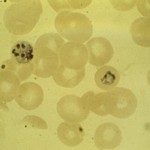Lien vers Pubmed [PMID] – 32003970
Lien DOI – 10.1021/acsinfecdis.9b00321
2020 03; 6(3): 379-392
Protein S-palmitoylation is an important post-translational modification (PTM) in blood stages of the malaria parasite, Plasmodium falciparum. S-palmitoylation refers to reversible covalent modification of cysteine residues of proteins by saturated fatty acids. In vivo, palmitoylation is regulated by concerted activities of DHHC palmitoyl acyl transferases (DHHC PATs) and acyl protein thioesterases (APTs), which are enzymes responsible for protein palmitoylation and depalmitoylation, respectively. Here, we investigate the role of protein palmitoylation in red blood cell (RBC) invasion by P. falciparum merozoites. We demonstrate for the first time that free merozoites require PAT activity for microneme secretion in response to exposure to the physiologically relevant low [K+] environment, characteristic of blood plasma. We have adapted copper catalyzed alkyne azide chemistry (CuAAC) to image palmitoylation in merozoites and found that exposure to low [K+] activates PAT activity in merozoites. Moreover, using acyl biotin exchange chemistry (ABE) and confocal imaging, we demonstrate that a calcium dependent protein kinase, PfCDPK1, an essential regulator of key invasion processes such as motility and microneme secretion, undergoes dynamic palmitoylation and localizes to the merozoite membrane. Treatment of merozoites with the PAT inhibitor, 2-bromopalmitate (2-BP), effectively inhibits microneme secretion and RBC invasion by the parasite, thus opening the possibility of targeting P. falciparum PATs for antimalarial drug discovery to inhibit blood stage growth of malaria parasites.

